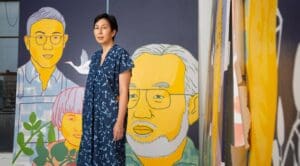Transforming Intergenerational Pain into Inspiration and Strength
-YK
91.3 KBCS Music and Ideas. I’m Yuko Kodama
Lauren Iida is a local artist whose work Adorns public spaces including the Washington State convention center, Plymouth housing in Seattle and Uncle Bob’s place in Seattle’s Chinatown international district a cross from the wing luke museum. Her artwork is often themed around the Japanese American experience.
You see, Lauren Iida’s paternal grandparents and great grandparents were forcibly removed and incarcerated along- side about 120,000 Japanese Americans by the US government during WWII. The event scarred the family. Lauren Iida’s artwork, usually made of hand cut paper is often inspired by photos, documents and oral histories found through Densho,, a repository to document this historical time for Japanese Americans.
Iida describes the approach to her artwork.
-LI
I create what I call paper cutaways, and they’re cut paper compositions that I make with a scalpel, like an Exacto knife.
I am biracial, my father is Japanese American – and the Japanese part of my heritage has always been kind of a mystery to me. Growing up as a child, I didn’t really have very much access to Japanese things – I think mostly because my grandmother was incarcerated during World War II at Tule lake. And after that, she tried to shed the stigma of the racism by raising her children in a very “American way”, so the only thing that made it down to me really was some Japanese foods. But I always looked at those things in a magical way. …Like, I wondered at those things….and I did want to know more when I was a kid, but there wasn’t really much information available to me. So as an adult, I’ve really focused on learning more and researching more on the topics of my Japanese heritage and being a Japanese American.
At first, I didn’t really know anything about any kind of history related to the incarceration of Japanese people, during World War II. I knew that it had happened, but it was such a small part of any conversation I ever had with my paternal grandmother, or with my father or really with anybody in my family. – So as I grew up, I sort of started to hear about it. I remember very briefly studying it at public school, but I had a lot of questions. – So as I grew up and discovered the Densho archives, I was really, really interested and fascinated by it. Just looking through all the photographs and documents and listening to oral histories.
And then I started to make art about it. But basically, as I got older, and I kept studying those things and researching those histories, I realized that it was natural to not really want to talk about those things for my grandmother especially. – And I understand why she wanted to put on an air of being very pro-America and very not-Japanese honestly. Because after being persecuted for her race, I can really understand why she raised her children that way, and why she acted that way. – But I think it’s a real shame. And it’s an injustice to me that I don’t get to know about my family heritage, my cultural heritage, because she was traumatized by the US government’s racist protocols. – And for a whole variety of reasons, many people are disconnected from their cultural heritage – displacement, if they’re refugees, if their parents were traumatized, if there was just a break in the lineage for any reason or break in the communication… I think it’s a really common situation that I’m in.
Regarding storytelling and passing down of information from our elders to us, it’s really complicated. – Because sometimes they don’t want to talk about things because of trauma. Because they don’t want to relive sad events for themselves. And sometimes they don’t want to burden us with negative or sad memories. And other times, I find that they just don’t think that it’s interesting. They’re surprised to learn that young people would think that their experience was interesting. My grandma Clara, who’s 102, She asked me the other day, “Why do you know so much about me? And why do you care?” And I said, because your life has been so fascinating and so interesting…and it’s been a source of inspiration for me and my artwork for many years…and it always will be. I study your life, and I’ve done a lot of research and I remember all the answers to all the questions that you give me. –And she laughed, like she was tickled by that.
I think it’s a really essential function of being a human being – finding out where we came from, and also trying to get the information that feels like it’s helping you put together the puzzle of who you are and who you want to be. When I learn more about the struggles that my ancestors and their peers went through, being incarcerated during World War II, it does give me more personal strength. I’m inspired by their stories, and I’m inspired by their optimism and their attitude and their strength and resilience, going through that really difficult time. (And) it does help me keep my own life struggles in perspective. (And) I think that is something that we often fail to do in our lives, especially in a privileged country like the United States.
There are people who are suffering around us here also in the US right now. And when we give something of ourselves to somebody else, and when we listen to somebody else’s story, we share an experience with them and we feel compassion for them. (and) We also learn something about ourselves. So, I really encourage people to, to share their stories and also listen to other people’s stories because everybody has a story, and the more we share our stories, the more we understand about each other, and hopefully the more we can get along.
-YK
That was local artist, Lauren Iida. She’s represented by ArtXchange. Iida will be unveiling a 30-foot paper memory net featuring symbolic objects from the book, Swimmers by Julie Otsuka. Tomorrow at 7 pm at the Seattle Public Library Central branch in downtown Seattle. For more information about the event and to support our work, you can visit kbcs.fm
Honoring the Nikkei Farmers of Bellevue
Artist, Lauren Iida
Remember and Resist – Day of Remembrance
Who Helped When We Were Incarcerated
Producer: Gol Holghooghi and Yuko Kodama
Photo: Paul Tomita
(Audio story to be posted soon!)
Day of Remembrance Remember and Resist Event 2/19/22
Saturday, February 19, 10:00 am–1:00 pm
At 10 am, meet at the Puyallup Fairgrounds (Blue Lot Parking, 311 10th Ave SE, Puyallup, WA 98372).
At 11 am, we will move to the Northwest Detention Center (1623 E J Street, Tacoma WA 98421) for a continuation of the program starting at 12 pm.
Weather permitting, there will be some outdoor programming. Masks and social distancing required.
February 19, 2022, will mark 80 years since the signing of Executive Order 9066, which authorized the forced removal and mass incarceration of all Japanese Americans on the West Coast and beyond. Most Japanese Americans in the Seattle area spent their first few months in detention at the Puyallup Fairgrounds (“Camp Harmony”) until their transfer to the concentration camps at Minidoka, ID, and Tule Lake, CA. The trauma of family separation, child imprisonment, poor sanitation, bad food, inadequate health care, and uncertain futures persists—and continues today at the Northwest Detention Center (NWDC) in Tacoma.
Gathering in the same location where barracks once housed incarcerees, survivors, their families, and community members will share the history of Camp Harmony and personal experiences there, before rallying at NWDC to remember and resist the injustices of the past and present. The program will also include a live taiko drumming performance by Fuji Taiko and a special ceremony to remember Japanese American concentration camps and incarcerates.
For RSVP or information: info@seattlejacl.org
Notes: Dress warmly. There will be one porta-potty facility available on the Puyallup site. Feel free to
bring signs, tsuru and noisemakers for the Tacoma portion of the program!
Takeaways from Japanese American Stories of Incarceration
For the past 24 years, Tom Ikeda, the founding Executive Director of Densho and his staff have been conducting oral histories of Japanese Americans who have endured the painful experience of being forcibly removed from their homes and incarcerated en masse by the United States government.
Harassment of Japanese Americans After the Pearl Harbor Bombing
Henry Miyatake’s Suitcase
The Local Japanese American Community after Pearl Harbor
On December 7th, 1941, Japan’s military attacked Pearl Harbor. On December 8th, the following day, the United States declared war on Japan.
This series of events forever changed the lives of the Japanese American community along the west coast of this country. This set of excerpts from the Densho Project oral histories, highlight what some of the younger local Japanese Americans experienced at that time.
Special thanks to the Densho Project for the audio.
Producers: Jim Cantu, Devin Williams and Yuko Kodama
Image: from the Densho Project
Commemoration of the Bombing of Hiroshima
On August 6, 1945, the United States dropped an atomic bomb on Hiroshima, Japan, resulting in estimates of over 200,000 deaths within months of the event. This was the first of two of the only nuclear weapons used on civilians in the world’s history.
Shirley Shimada’s family is from a fishing village outside of Hiroshima. She shares her family’s stories about how bewildered the Japanese people were with the impact of this new munition. (more…)



